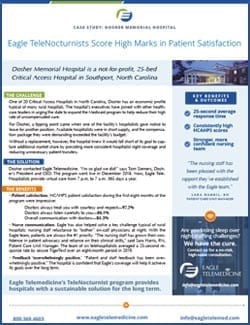Telehealth in rural areas is important to providing round the clock care to patients in these communities. Dosher Memorial Hospital turned to TeleHospitalist coverage to improve support for its nursing staff. This not-for-profit, 25-bed Critical Access Hospital (CAH) is located Southport, North Carolina.
CHALLENGE
One of 20 CAH in North Carolina, Dosher has an economic profile typical of many hospitals in small communities. The hospital’s executives have joined with other healthcare leaders in urging the state to expand the Medicaid program to help reduce their high rate of uncompensated care. A common solution for improving compensation to CAH is offering telehealth in rural areas. For Dosher, a tipping point came when one of the facility’s hospitalists gave notice to leave for another position. Available hospitalists were in short supply, and the compensation package they were demanding exceeded the facility’s budget. Without a replacement, however, the hospital knew it would fall short of its goal to capture additional market share by providing more consistent hospitalist night coverage and reducing unnecessary patient transfers.
SOLUTION
Dosher contacted Eagle Telemedicine improve support to its nursing team. “I’m so glad we did!” says Tom Siemers, Dosher’s President and CEO. The program went live in December 2018. Now, Eagle TeleHospitalists provide virtual care from 7 p.m. to 7 a.m. 365 days a year. Eagle is providing telehealth to rural areas to increase access to care for patients in smaller communities, like Southport.

